"This was made with a lot of love by people who knew him, who lived with him. It has the essence of what he was," one of Pelé’s sons said.
SANTOS, State of São Paulo — The mausoleum built for the golden casket of Pelé was opened for visitors on Monday.
On the second floor of a vertical cemetery in Santos, outside Sao Paulo, the mausoleum welcomes fans with two golden statues of Pelé; the floor is artificial grass; the walls are images of fans in a stadium; and there's an endless soundtrack of cheers, as if Pelé was still playing. The ceiling above the casket of the three-time World Cup champion is blue.
Pelé was laid to rest here on Jan. 3, five days after he died at age 82 of colon cancer.
“This was made with a lot of love by people who knew him, who lived with him. It has the essence of what he was,” an emotional Edson Cholbi do Nascimento, one of Pelé’s sons, said after a small ceremony with family and friends.


The mausoleum was planned by the owner of the cemetery, Pepe Alstut, who died in 2018.
Alstut hoped the mausoleum would be on the ninth floor, overseeing the Santos club's Vila Belmiro Stadium, where Pelé starred for 18 years. His family, instead, buried him on the second floor so fans could have better access.
“I am shaking. The energy of this place is surreal,” said Erica Nascimento, a tearful 42-year-old economist.
Former footballer Roberto Milano, 56, was also moved.
“He is part of my life," Milano said. "As we grow old we need to follow the best role models. Maybe he was the biggest of them all of these role models.”


Fans willing to attend must book a time on the Memorial cemetery website.
Pelé led Brazil to World Cup titles in 1958, 1962 and 1970. He is the only player to win it three times. Last month, a Brazilian dictionary added “Pelé” as an adjective to use when describing someone who is “exceptional, incomparable, unique.” The announcement by the Michaelis dictionary was part of a campaign that gathered more than 125,000 signatures to honor the late soccer great’s impact.
AP journalist Mauricio Savarese in Sao Paulo contributed.
.png)









 English (US) ·
English (US) ·